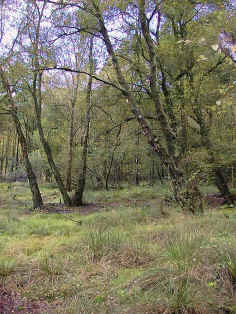
The Wet Woodland Bird Survey
Introduction

| The Wet Woodland is an area located on the north west
side of the Woodland
Education Centre's steep-sided valley (map). It is an extremely diverse area of approximately 2 hectares,
which includes a central area of wet woodland surrounded by a number of very different
dryer woodland zones. A plant survey of
the Wet Woodland area identified six different regions based on differences in the tree
species and ground vegetation within the area. These areas have been named as: The Mound The Bluebell area The Cherry area The Stony area The Clearing The Wet area. A small part of the southern area of the Wet Woodland, near to the access bridge, was not covered by the detailed plant survey because it was not deemed sufficiently different to separate out. For the purposes of the bird survey, this area was called the Oak area. The bird survey was related to these seven areas, in order to see if differences in the vegetation affected the type of birds recorded. The Wet Woodland comprises a mixture of different types of trees and habitats, including open areas, which make it ideal for song birds (small birds such as Robins and Wrens). The area provides nesting and feeding sites, song perches and safe tree cover which helps small birds to avoid predators. The majority of the birds, mainly Tits and Goldcrests, when feeding, stay high in the canopy picking off insects from the leaves. They prefer the Willow trees common in the wetter areas of the woodland, which are particularly rich in invertebrate life. The Tree Creepers and the Nuthatches prefer older and more mature trees which have many cracks in the bark, so that the birds can easily pick out insects from within the cracks. The only real ground feeding birds recorded were Robins, Dunnocks and Blackbirds which tended to stay on damp ground picking up invertebrates from the mosses. The survey was carried out in July when invertebrates were abundant. All the song birds recorded in the wet woodland at this time were insect eaters, as opposed to seed and berry eaters. However, this might well change in the autumn as the number of seeds and berries in the area increases. A Buzzard seen in the area was probably breeding very nearby and using the larger trees in the wood as a resting spot. It picked this part of the wood as it is very close to feeding areas such as the nearby heath, which would contain many rodents. Two Warbler species were recorded during the survey. These were the Chiffchaff and the Blackcap. These birds sang much more than the other birds, the Chiffchaff singing from high, open branches, while the Blackcap sang from fairly low down in the scrubby bushes. These are typical places from which to see the birds singing. Most of the other bird noises were high pitched 'seeps' coming from Tits and Goldcrests high in the canopy and Tree Creepers lower down. The Spotted Flycatcher also produces a very high pitch, 'squeaky gate' like call which is used so that they can stay in contact with each other and their young. Although the survey was conducted in relation to different plant areas within the wet woodland, the results showed that most of the birds appeared to be unaffected by the ground cover. The exceptions to this were Robins and Blackbirds which are both ground feeding birds and Wrens who hide in ground cover. The majority of the birds are only interested in what the taller trees and bushes are like, and whether they contain lots of insects to eat or places to nest, sing from, or to hide in. |